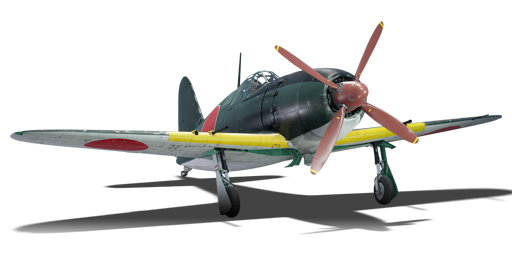



The J2M5 Model 33, designated as Raiden Mod.33 (雷電三三型), was a high-altitude variant of the Raiden series which was developed to increase the ceiling and effectiveness at high altitude. Equipped with the Mitsubishi MK4U-A "Kasei 26a" engine with a mechanically driven supercharger, giving increased high-altitude speed at the expense of range. Unlike the failed J2M4 Model 32, the Model 33 saw (limited) production and deployed to several air units.
It was introduced in Update 1.51 "Cold Steel". Similar to its preceding variant, the J2M4, the J2M5 boosts its performance over its earlier predecessors by boasting a 1,854 hp engine on top of equipping a turbocharger increasing its efficiency at high altitudes. With the engine shaft remaining relatively the same over the previous J2M2/3, the J2M5 enjoys the same weight distribution with a stronger engine. Still excelling at climbing, the J2M5 plays more similarly to the J2M2's performance-to-BR with the firepower of a J2M3.
flaps
flaps
flaps
brake
| Belt | Belt filling | Armor penetration (mm) at a distance: | |||||
|---|---|---|---|---|---|---|---|
| 10 m | 100 m | 500 m | 1000 m | 1500 m | 2000 m | ||
| T/FI/FI/APHE | 26 | 24 | 17 | 10 | 6 | 4 | |
| HEF-T/HEF/HEF/APHE | 26 | 24 | 17 | 10 | 6 | 4 | |
| APHE/APHE/APHE/APHE/HEF/HEF-T | 26 | 24 | 17 | 10 | 6 | 4 | |
| HEF-T | 4 | 4 | 4 | 4 | 4 | 4 | |
| HEF/HEF/HEF/APHE/APHE | 26 | 24 | 17 | 10 | 6 | 4 | |
| Belt | Belt filling | Armor penetration (mm) at a distance: | |||||
|---|---|---|---|---|---|---|---|
| 10 m | 100 m | 500 m | 1000 m | 1500 m | 2000 m | ||
| T/HEF-I/HEF-I/APHE | 19 | 18 | 12 | 7 | 5 | 4 | |
| HEF-T/HEF/HEF/APHE | 21 | 20 | 13 | 8 | 5 | 4 | |
| APHE/APHE/APHE/APHE/HEF/HEF-T | 21 | 20 | 13 | 8 | 5 | 4 | |
| HEF-T | 4 | 4 | 4 | 4 | 4 | 4 | |
| HEF/HEF/HEF/APHE/APHE | 21 | 20 | 13 | 8 | 5 | 4 | |












Flight performance | |
|---|---|
Survivability |
|---|
Weaponry | |
|---|---|